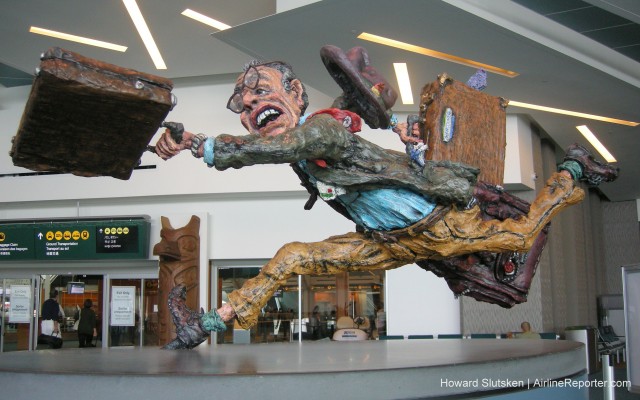
“The Flying Traveller” by Patrick Amiot & Brigitte Laurent at Vacouver’s airport
Consider these two scenarios:
Scenario One: an elite flyer with a major US air carrier files a claim with his preferred airline to have his elite status bag tag replaced, for it was inadvertently damaged during his last flight. It did remain attached to his checked luggage handle. Basically, it was bent. He is upset and advises this is the second such claim he has made within a month. He files a claim for his damages due to poor handling of his luggage.
Scenario Two: a not-so-frequent flyer is returning home on a recent flight. Once home, she starts to unpack her bag when she notices that her small, stuffed teddy bear (which she got several years prior after she survived open heart surgery and is now her ’œtravel companion’) has been damaged. It was split on the back seam, indicating someone may have inspected it for contraband. This little bear goes with her on all her trips, no matter how insignificant. In addition to the teddy bear being damaged, she notices that her luggage has been searched, as her well-folded and neatly-packed bag is now in disarray. She files a claim for damages.
Question; which claim will be settled? The answer will be at the end.
First, let’s dig a bit deeper into the world of airline baggage claims and talk how to get the best results when things go wrong.
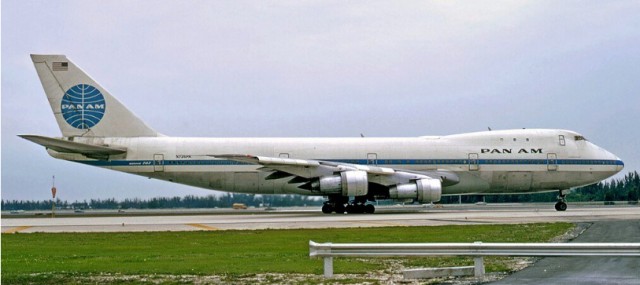
A PanAm Boeing 747-100 – Photo : Bob Garrard
Historical Perspective on Airlines
Traveling by air nowadays is as common as getting in one’s car to go to the grocery store. I grew up in an era and time in a town when everyday individuals (non-AvGeeks) would go to the airport just to watch airplanes takeoff and land. All airports of this time had observation areas or lounges specifically designed for non-passengers to enter and watch the airplanes. These areas overlooked active runways and taxiways so all could watch the maneuvering of the aircraft to and fro.
The town in which I grew up benefited greatly for having a major international airport as a neighbor. Fellow students at my high school had at least one parent, cousin, uncle, or aunt that worked for an airline at the airport. Salaries were good and the benefits were even better. Travel privileges allowed them to visit locations that only a few could imagine.
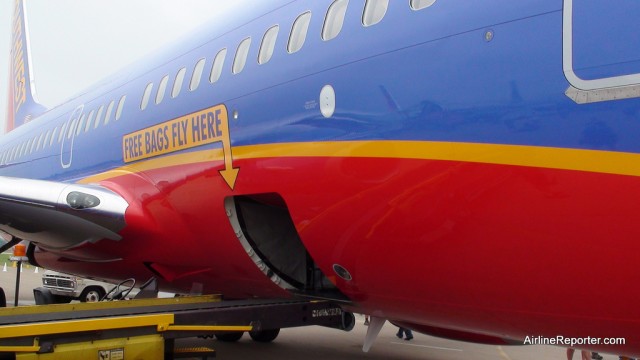
Southwest still lets your bag fly free – Photo: David Parker Brown
With the number of legacy carriers or major airlines left in existence being limited because of deregulation, and the enhanced airport and airline security measures since 9/11, many things with the airlines today have changed. However, as much as things have changed, some components still exist as they did in the past. Filing a claim with an airline for baggage damages, out-of-pocket expenses reimbursement due to delayed bags, and pilferage-missing items from checked luggage has not changed over the years other than to say that the number of claims filed has increased partly due to the increased number of people traveling by air.
I have worked in the airline industry for over 30 years. I have held various positions and one of the most educational positions has been in the department of the airline titled “Consumer Affairs.”
One aspect Consumer Affairs handles are the complaints involving baggage handling, i.e. damages, lost luggage, or any other issue associated with a passenger’s bag. Filing baggage complaints undoubtedly is one of the most prominent issues all carriers of any size handle regularly. So much so, airlines have to report immediately to the Department of Transportation (DOT) when they receive a complaint letter or email from a passenger.
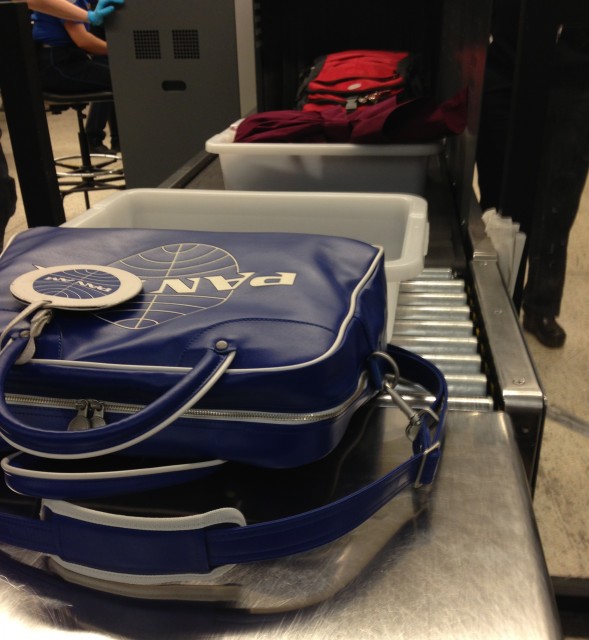
Some bags are more important than others – Photo: AirlineReporter
How to Successfully File a Damage or Lost Baggage Claim
If there is one constant in air travel, it will be delayed or damaged bags. The most common reason for frustration faced by people who have filed a claim with an airline is because they (passengers) have improperly submitted the claim. This, in turn, causes a delay in them receiving restitution for their claim. What makes a proper claim for quick settlement includes just a couple of simple elements.
The major first step of any claim is documentation. Supporting documents are a must and will validate a passenger’s statement that they were on a particular flight. DO NOT throw any supporting documents (ticket receipts, baggage claim checks, and baggage file reference numbers) away during or after your flight ends. Most individuals do not unpack their luggage immediately after arriving home. So it is very important to maintain those documents until you have settled in.
Submitting proper documentation confirms and solidifies one’s legitimacy for a claim. Clear and legible copies will ensure one’s claim will be handled expeditiously, in a timely and a professional manner. Airlines may be different on the procedures and have different fees associated with bags but all require the same basic information for claims.
Keep in mind that this article only focuses on filing a claim directly with the airline; many credit cards provide some type of lost/delayed baggage coverage, which may be easier to claim. Now, back to the story!

Alaska Air ramp ops at SEA
Representatives assigned in compiling customer information seek the following pertinent information:
- Passenger Name ’“ correct spelling and the actual name as it appears in the reservation is a must
- Itinerary ’“ flight numbers, dates of travel, verified by copies of tickets and ticket numbers, boarding passes, and baggage claim checks
- File Reference Numbers ’“ when traveling, if you have initiated a baggage claim by filing at the airline’s Baggage Service Office (BSO) located at the airport, you will receive documents with a file reference number. This number and any copies of paperwork received should be submitted as well
- Permanent Address ’“ current permanent address, telephone number, and a valid email address should be provided. Nowadays, most communication is conducted via the web, so providing an accurate email address is important and aids greatly in fast communication with any airline
After submitting the information, settlement expectations should be anywhere from four-to-six weeks. Providing airlines with the most accurate information ensures that your claim will be reviewed without delay.
Just a reminder and a few tips on traveling as it relates to checking luggage. Know the airlines Limits of Liability and pay close attention to and understand their exclusions – items the airlines don’t cover and won’t compensate you for.
Limits of Liability
All airlines adhere to the same liability limits when settling loss baggage claims. The limits are as follows:
- Domestic Limit of Liability – $3,400 per ticketed passenger
- International Limit of Liability – $640.00, or $9.07 per pound (weight of the luggage)
- International limits are governed by the Montreal Convention 1000 SDR (Special Drawing Rate) per ticketed passenger.
Liability restrictions and exceptions may vary between air carriers, but each is similar in makeup and desired purpose. Some examples of restrictions and exceptions are as follows:
- Maximum liability is not automatic. Damages or loss of value must be proven
- Airlines are not liable for unsuitably packed items
- Airlines are not liable for loss, damage, or delay of baggage that may result from a security search conducted by any local, state, or federal agency
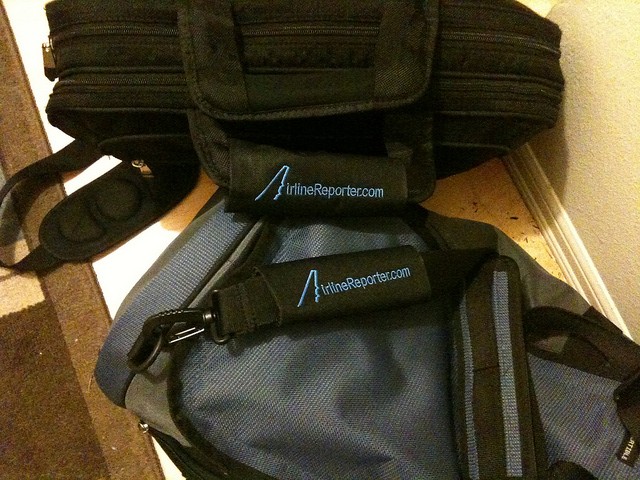
Some AirlineReporter love on bags – Photo: David Parker Brown
Exclusions
Exclusions are items that airlines will take no responsibility or have any liability for when handling their luggage. Most excluded items are the same with each air carrier. Examples of excluded items include, but not limited to, the following;
Cash, camera equipment, commercial effects, computer software & equipment, electronic equipment, fragile articles, jewelry, lifesaving medications, negotiable papers, irreplaceable business documents, works of art, or other similar valuable items contained in checked or unchecked baggage.
Many passengers travel to Central and South American countries and will attempt to check televisions, refrigerators, and other appliances. Most air carriers will not accept these items as checked, especially if they are not packaged in their original containers.
Keep receipts. If you’re seeking reimbursement for out-of-pocket expenses or loss due to a delayed bag, you need to provide any copies of receipts of purchases made in association with your claim. The importance of complete and detailed support documents is just as important, if not more so, when filing a claim with a partner carriers.

Loading up a United flight – Photo: David Parker Brown
Answer to the Bear / Elite Tag Scenario
Now, to answer the question I asked in the beginning – which claim scenario will the airline settle first and provide a positive response to the customer? In the real world, it will be expected that both scenarios will have a positive reply. Actually, both individuals will get a reply from the airline, or a least they should. However, one will be what the customer wants and the other will be something a little different. The tag is easy enough to replace, but to find the amount of damage to the bear and what the replacement costs of a new bear becomes a bit more challenging.
Understand, all customers are important but regrettably not all customers receive what they seek.
This story was written by Gary St. John for AirlineReporter.
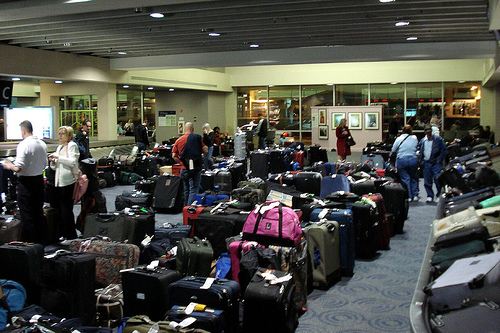
I used to work in baggage service. Here’s a few tips:
1) Don’t pack important medications in checked luggage.
2) Don’t pack car/house keys in checked luggage.
3) Remember, Baggage Service is there to help you. It’s not their fault, so being rude will not get your bags found any faster.
4) Use bag tags and anything else that you can tie or attach that helps distinguish the bag from others.. Remember what the bag looks like,.as well as contents. The more info you can give the faster they can get it back.
5) Demand vouchers for items you need immediately. Baggage Service can get you toiletry kits, but if you need clothes for an important meeting/wedding/funeral, demand a voucher!
Roughly 3 years ago, I flew on a business trip from ATL to BLR via CDG, flying on Air France. My checked bag (a piece of hard-side luggage) was missing on arrival (it showed up later, crushed, cracked open and inside a plastic bag; the damage occurred at CDG). The Air France BSO provided a claim form, but also said I had to go to AF’s web site and claim there. After a few days, AF responded that since I lived in the US, I would have to file my claim via Delta’s web site (no database sharing, evidently). This led to weeks of finger-pointing between the airlines, then a denied claim by Delta (!!!). After much phone tag, I finally talked to a real person. The conversation seemed to be going nowhere until I got positively irate. From the get-go, I supplied pictures of the damage, pics that I’d taken immediately upon receipt of the bag. For awhile, this was not even acknowledged. Finally, a modest settlement was proposed, and I accepted. — But back to the question of a voucher for immediate needs (clothing, etc): I was told to return to the airport with receipts, and I’d get reimbursed up to some INR value. By the time I added up what I’d spent, it was roughly the same as the cost of taking a taxi from the city out to the (remote) airport and back; i.e., not worth the trip.
I was on a Czech flight into PRG two years ago, and my bad came down the belt several minutes behind everyone else. It had a brown sticky goo on part of it that had seeped through into the bag… Any idea what might have caused this and what the goo might be?
…Probably should have filed something, as the bag is ruined…
oh well